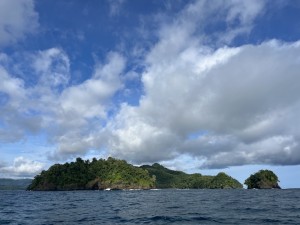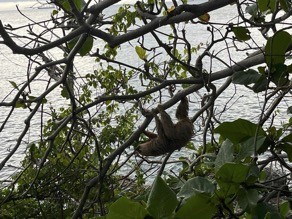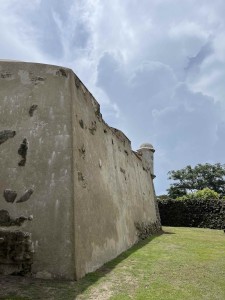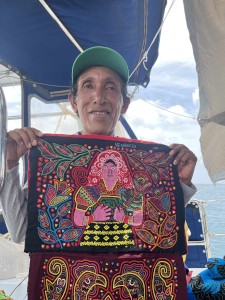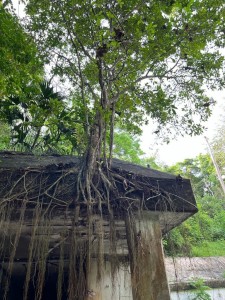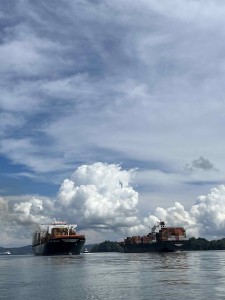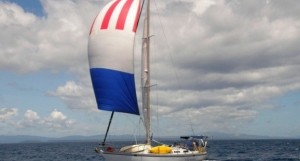Tokimata's Travels
| Vessel Name: | Tokimata |
| Vessel Make/Model: | Ganley S130 steel cutter |
| Hailing Port: | Coromandel, New Zealand |
| Crew: | Peter, Rachel, Danny and Tom Garden |
06 September 2023 | Bahia Nonda
Panama Pacific Coast
It’s now well over a month since we left Panama City. La Brisas the free anchorage on the long causeway joining three islands, was free but not the greatest pace to stay, with poor holding and many disintegrating boats, but this amazing backdrop of skyscrapers behind. These free places where yachts [...]
07 August 2023
Panama City
We fuelled up on 20th July 2023 and filled with water, ready for the passage through the Panama Canal. We were to leave around 2 pm next day, staying overnight in Gatun lake with our local line-handlers, and should be through by 3 pm on the following day.
21 July 2023
Rio Chagres and Portabelo on the Caribbean coast of Panama.
We left the San Blas islands on July 10 2023, after a last visit to Ivin, the wonderful chef at Hollandais Cays. He gave a few more image files for his recipe book and we bought his terrific coconut cake one last time. At 11.30 we upped anchor and were off on our way back east, the transit through the [...]
13 July 2023
The islands of San Blas
On Friday 23rd June at last we headed across the busy canal entrance from Shelter Bay marina and into the Caribbean sea. We were sailing to the San Blas islands, Kuna Yala to the inhabitants, hundreds of small islands and coastal villages that are still administered by the indigenous owners of the land. [...]
30 June 2023
The jungles of Panama
Grinding rust on the hull of Tokimata eventually gave way to grinding rust on the decks, but this was made much easier by hiring energetic boatyard workers. Eventually this progressed to painting, using two part polyurethane over the various anti-rust treatments and primers they had applied. However [...]
07 June 2023
Two weeks in Panama
We arrived in Panama City Tuesday 23rd May from Manchester, with our usual heavy luggage: this time a Starlink system was the bulk of it along with other boat essentials. After travel via Amsterdam we arrived at last to see our taxi-driver holding a “Mr Peter” sign and were off for the hour and a [...]
Beaufort Sea Coast
Herschel Island is now a Canadian Parks site and has quite a history. It is a small island about 40 miles inside the Canadian border, but it was used as the main base for whaling by American whalers in the 1890's for the arctic whaling fleet. In 1895 15 whaling ships and 2000 people wintered over in the bay so they could get an early start on the next whaling season without having to fight through the ice around the top of Alaska. It was apparently a lawless and pretty horrible place until the Canadian mounties turned up around 1900 and started enforcing Canadian sovereignty and cleaning it up. But the bowhead whales were pretty much wiped out by then and a few missionaries and Inuit survived until the 1930s when it was abandoned. There is a graveyard with a couple of dozen graves of young whalers - most in their early 20s who died here while wintering over. Now it has two park rangers living in one of the old historic buildings over summer and a few visitors and quite a few scientists staying for weeks at a time. There are 20 German scientists there at the moment studying permafrost slumps. They are looking at how the permafrost is melting and huge pieces of the coastline are falling into the sea and eroding very quickly as the permafrost no longer holds the ground together. One of the biggest slumps is visible form the island where the coast is retreating 15m per annum - the foot print of global warming.
There are two factors causing positive feedback of global warming in the arctic (i.e. making it worse). One is that as the permafrost melts it releases carbon into the atmosphere - loads of organic matter is locked up in the frozen ground but is released as methane as it melts. The second fact is that as the ice coverage gets less there is less reflection of the suns heat back into space, and the now open ocean absorbs more heat making matters worse. These two factors mean that the arctic is heating up way quicker than anywhere else on the planet.
Three days ago we stopped for two nights at a place called Demarcation Bay just before the border. It was surrounded by tundra and a herd of musk ox were grazing on the shore as we came in. They pretty much ignore people but if you approach closer than around 100m the bull comes out in front and stares at you and the females and calves form a defensive ring. Any closer again and the bull will charge at you. Apparently more people are killed by musk ox than bears in Alaska. There were some musk ox skulls on Herschel Island and the entire top and front of the skull is covered in this massive thick horny bone leading out to their vicious horns. People say if one attacks you don't shoot it in the head and I can see why. All the boats are carrying guns now as there is a real danger from polar bears (near ice), musk ox and grizzlies (on the mainland). The tundra is alive with colourful small flowers and we even picked enough blueberries for two days worth of blueberry pancakes for breakfast! We expected Alaska to be alive with bugs and mosquitos, but wandering on shore at Demarcation Bay at 11pm picking berries is the only time we have been bothered by them. Out at anchor there is no sign of mozzies at all.
100 miles before Demarcation Bay, at the end of the ice that we had been dodging for 2 days, we stopped for lunch at a small island called Flaxman Island. This was the site of the camp of Danish explorer Mikkelsen who was searching for a continent supposedly in the Beaufort Sea a few hundred miles from the coast. He did several long sled journeys out over the ice looking for it in the early 1900's. His ship was destroyed by ice and he used the remains of it to build some huts on Flaxman Island. We have been traveling with the Danish yacht "Sol" and they were keen to have a look ashore so we went in and looked around the island. We found the remains of several Eskimo sod houses and what looked like the remains of Mikkelsen's huts. We also found what looked like a piece of sled made of oak and some pieces of barrel which could date back to that time.
Because of the persistent westerly winds, we have so far used only about one third of our fuel on the run from Nome to Tuk - a lot less than we expected. But we understand Tuk is quite a typical artic native town - not westernised as much as Cambridge Bay, so it will be good to see it and top up the diesel anyway. The west winds are due to continue 4 or 5 more days so we will keep moving after a 24 hour stop and ride the wind to Cambridge Bay.
